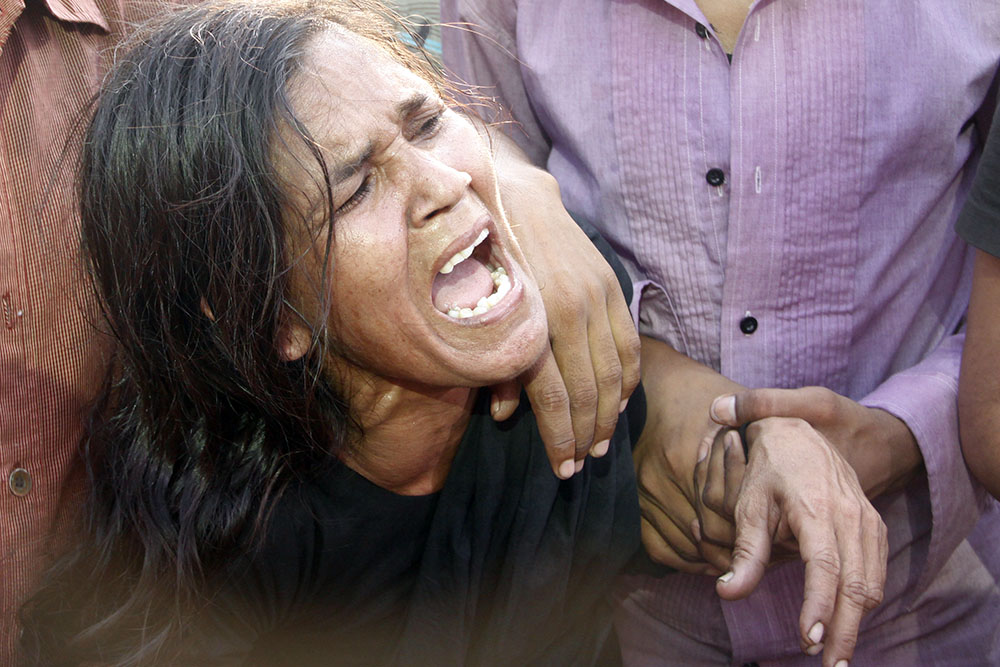“My head is spinning,” Aklima said to me in Bangla.
It was a chilly spring day in Chicago, and Aklima was a labour activist who had come from Bangladesh as part of an anti-sweatshop activist tour. She was a slender, pretty 20-year-old Bangladeshi who’d been working in factories since age 12. Last year, she’d been one of the 3,500 workers inside Rana Plaza when it collapsed.
Her account of the Rana Plaza disaster was like many others. Through a translator, she described the situation before the collapse. (She mentioned that some managers physically hit the workers who were balking at entering the factory, among other details.) When she reached the part about the collapse itself, she dropped her head low and stopped looking at the crowd. In a flat voice, she described becoming trapped under a machine near the body of a man who had been killed. After 12 hours, one of the many volunteers who had spontaneously come to rescue workers found her.
After Aklima explained this, she abruptly fell silent for a moment and then changed the subject. “Till now, I have not gotten any compensation,” she added before concluding her speech.
Later, Aklima acknowledged the impact of the atrocity without hesitation. “I am physically ill and mentally ill,” she said, describing constant fear. (This may have explained her dizziness, too.)
She said many other survivors were mentally ill. In that, she is objectively correct.
Soon after the collapse last year, I talked to a psychology professor at a university in Dhaka. He talked about post-traumatic stress disorder (PTSD), a mental health problem that arises after people survive a life-threatening or terrifying situation. He predicted there would be about 1000 cases of PTSD after Rana Plaza.
A year later, it seems clear that was too optimistic.
In autumn, global labor organization IndustriALL said nine of every ten Rana Plaza survivors are too psychologically unwell to work. Unpublished data from two sources has confirmed mental health problems in the large majority of workers. (One psychiatric assessment also identifies increased mental health problems in families. We know rescuers are also suffering emotionally.)
While researching mental health in Bangladesh, I’ve never found anything to suggest that Bangladeshis have any special propensity towards mental disorders. Bangladesh has about the same prevalence of mental health problems as other nations. (Globally, about one in every six or seven persons has a diagnosable mental illness.) There is no logical way to explain psychological difficulties in nine of every ten Rana Plaza survivors except for the factory collapse itself.
Yet that incredible statistic is logical. There are identified factors that make people vulnerable to psychological problems after a disaster. Rana Plaza has many of them.
To begin, the mind knows the difference between accident and intentional harm. The latter is far more disturbing. When Information Minister Hasanul Haq Inu told the international press, “It is not an accident, this is a killing incident,” he inadvertently explained why workers’ mental health burden has been so heavy.
The exceptional horror of being killed was compounded by the horror at lacking the power to avoid an atrocity foreseen. Many studies show that people who have had less power in a traumatic situation have more vulnerability to emotional problems after a disaster. This describes the workers at Rana Plaza, who were coerced to enter the building they feared would collapse.
Their low wages made it harder to avoid the disaster, and, like Aklima, many workers still have not received any compensation. This, too, contributes to ongoing emotional suffering. Poverty deprives these workers of the healthcare, comfort, and security that would make healing from trauma more attainable. Workers who are injured or disabled suffer this burden doubly.
Overall, workers had an exceptionally high risk of developing mental health problems after the disaster. Mental health professionals could see this in the first days after the collapse.
This is no small thing. The most common diagnosis is post-traumatic stress disorder (PTSD). This is an injury, not an illness. It is often very painful. Basically, when a person experiences overwhelming fear or a life threat, the intensity of that experience can damage parts of the brain that control memory, sleep, and emotion. The result is a cluster of symptoms, including inability to remember or painful intrusive memories of the event; insomnia, nightmares, and inability to rest; and sadness, rage, or suicidal feelings. Untreated, PTSD can involve extreme suffering.
But there is good news. People can heal. Mental health is sometimes taboo because people think disorders are permanent. In the case of PTSD, this is often untrue. People can make great improvements, and many can recover fully. Climbing out of darkness is hard work, but the resilience of people like Aklima – who has the will to endure dizziness and tell her harrowing story – should not be disregarded.
Helping people get better is cheap and feasible, too. It can involve social support, medication, or psychotherapy with a mental health clinician. Psychotherapists, who are trained in helping people experiencing psychological distress, can do an incredible amount to help people survive and thrive.
A few organisations provided limited mental health services in the immediate aftermath. The National Institute for Mental Health in Dhaka has offered free mental healthcare to survivors. This is only to be praised.
Yet it was not enough. Proper care requires sustained support over months. Adequate care involves dedicated mental healthcare professionals and outreach to workers who returned to distant villages.
To date, that work remains undone. It’s not part of any international agreement. If there are non-profit funds dedicated to it, they are insufficient to reach most people.
That shouldn’t be the case. People have been dying of their mental injuries since early May. Help should not be delayed any longer.
Calls for compensation to workers are beginning to work, and workers have empathy from people worldwide. (“My heart goes out to this young lady,” a worker from Chicago said during her presentation at the same event where Aklima spoke.)
Today, let’s add a demand for brands to fund workers’ mental healthcare. Aklima deserves it. All the workers, their families, and rescuers do.
– See more at: http://opinion.bdnews24.com/2014/04/23/mental-health-after-rana-plaza-one-year-later/#sthash.dmsv07op.dpuf
Source: Bd news24










